How To Keep A Wig From Slipping
We all know more and more black girls tend to wear various human hair wigs to show their beauty and charm. However, there is a common annoyance in this process: many girls are afraid their wigs fall off. How embarrassed it is! In order to avoid this case, we will give you several ways you can use to keep a wig from slipping without any hassle.
Method One: Silicone sheets
Silicone sheets are a brilliant tool that can help you keep your HD lace wigs from slipping as they can cling to your head and wigs to ensure that your wigs are completely kept in place. Here we highly recommend Jon Renau silicone sheets for you as they are so soft, so comfortable, and have totally stopped your wigs from creeping up.
How To Secure A Wig With Silicone Sheets
Step 1: Prepare silicone sheets in advance and cut the silicone sheets into your desired size and shape.
Step 2: Use sewing pins to pin these small silicone strips into your wig cap in position. We advise you to place one piece for the nape of your neck, one piece for near your hairline, and two pieces for behind your ears.
Step 3: Ensure to stitch around the border of each strip, check that the anti-slip side faces away from the wig lining, and then secure the wig to your head.
Note: If you do not understand how to sew, please have a sewing class or avoid using silicone solution strips.
Cons:
1. Care needs to be taken when sewing the silicone sheets into your wig. If you rip or tear your wig while you are sewing within the sheets, you can ruin your wig forever.
2. Although the silicone sheets can’t stretch out, they are not very breathable.
Method Two: Metal Wig Clips
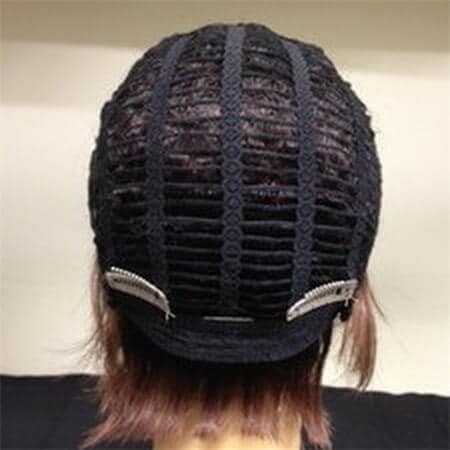
There is no doubt that metal wig clips are another fantastic solution because they are often sewn into wigs in order to fully attach them to your hair in place. Some wigs come with pre-attached metal wig clips, but if not, these wigs that don’t have metal wig clips before can be easily added.
More importantly, clips are very low-maintenance. Once sew into the wig cap, you don’t have any worry again. And it is very ideal for those people who are very hurrying in the morning.
How To Keep A Wig From Slipping With Metal Wig Clips
Step 1: Opt for some metal wig clips that match with the wig color in advance so that they can blend into the wig seamlessly.
Step 2: Decide where you want to secure these metal wig clips in your wig lining. We recommend spacing them along the edge of your wig evenly and sewing them in. Of course, you can freely add these metal wig clips to the back and middle of your wig lining, too.
Step 3: Sew the clips securely into your wig cap and ensure that the rubber strips face the wig lining.
Of course, the number of clips and size you need to use will be dependent on the style and how secure the wig feels.
It’s good to do a few trial runs of securing the wig with clips before wearing your wig out, just so you feel comfortable and confident with where you have placed the clips.
Con:
Wig clips will only work if you have some natural hair and are not wearing a wig cap.
Method Three: Wig Grip Band
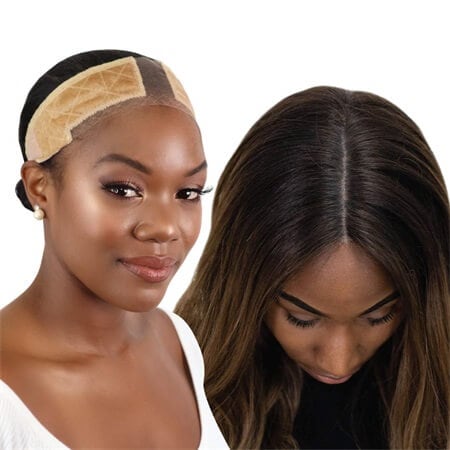
The wig grips are is similar to headbands and usually made of double-sided velvet and can hold your hair or skin on one side designed and one side that grips your headcover or wig.
Whether you have hair or no hair, wig grips are one of the most popular and effective ways to keep your wig in place all day.
Another great benefit of wig grip bands is that they can help to prevent headaches, which can be a common problem for wig wearers. The band redistributes the weight of the wig evenly, which helps relieve some pressure.
Wig grips are also an ideal method for you when you want to be able to easily remove and replace your wig during the day.
How To Secure A Wig With A Wig Grip Band
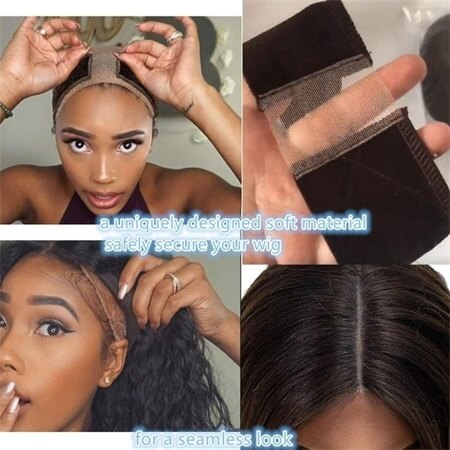
Step 1: Pin all of your hair to your head and be sure to use hairspray or hair gel to smooth any flyaway hairs to your scalp.
Step 2: Place the wig grip above your hairline and use the velcro strap at the back to adjust the wig grip.
Step 3: Gently place your wig on top of the wig grip, starting by placing the front of the wig on your head, then two sides, then finally the bottom.
Step 4: Shake your head from side to side to make sure your wig grip isn’t too loose. If it is, please remove the wig and start again.
Con:
The wig grip will last for approximately six months if cared for correctly. But over time, it may lose its elasticity and would need replacing regularly.
Method Four: Wig Cap
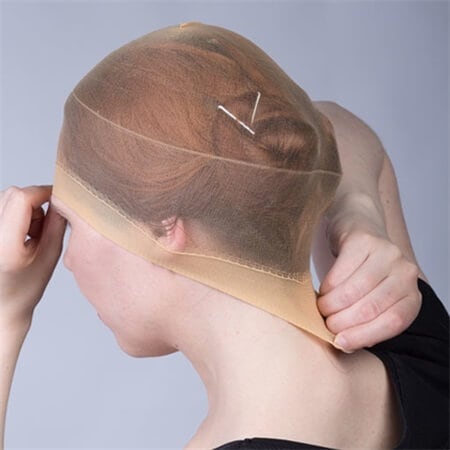
Believe it to not, a wig cap will be a perfect choice for those who want to know how to secure a capless wig. Wig caps also work well for those without natural hair. After all, it can create a safe and sanitized barrier between the wig and scalp, maintain the cleanliness of your wig and reduce itchiness.
As a simple tool that will help keep your wig on, the wig cap also can help you protect your scalp and guarantee that long or short natural hair will stay in place. In addition, there are various materials for you to opt for, such as nylon, cotton, and mesh.
How To Keep A Wig From Falling Off With A Wig Cap
Step 1: Dip a cotton ball in rubbing alcohol and rub along your hairline, which can remove oils, makeup, and dirt that can make a wig cap slip around, whether you have hair or not.
Step 2: If you have longer hair, tie it up securely in a low bun or low plait and then apply gel or hairspray to smooth down baby hairs or flyaways.
Step 3: Put both your hands inside the wig cap and slightly lengthen the cap. Place the wig cap on your head from the front to the back.
Step 4: Flatter the cap to make sure there aren’t any air pockets and it aligns with your natural hairline.
Step 5: Place the lace part wig on top of the wig cap in the same way you put on the wig cap.
Con:
The potential downside of wearing a wig cap is that it can cause you to feel the heat, sweaty, and uncomfortable.
Method Five: Bobby Pins
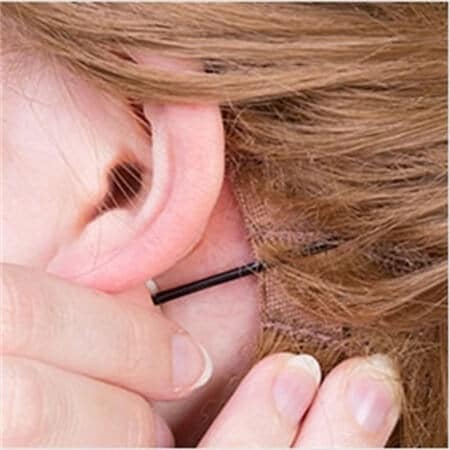
Using bobby pins is a super simple and affordable method to keep a wig on your head steady. And it is an excellent option for those people who have lots of natural hair, even requiring no maintenance. And it is definitely a great try if you have sensitive skin and often experience irritation from the materials of wig caps, wig grips, and silicone sheets.
How To Secure A Wig With Bobby Pins
Step 1: Firstly use some bobby pins to flatter down and secure your natural hair before putting on the wig.
Step 2: After putting on and styling the wig, you pull a part of your hair and place some bobby pins through the wefts into your natural hair. In this process, don’t forget to opt for some bobby pins that match your wig color, which will look more natural. Of course, you need to place as many bobby pins as you can to keep your wig secure and comfortable.
If your wig isn’t wefted, you can use bobby pins to secure your wig to your natural hair around the side of the wig and by your temples.
Con:
If you don’t use enough bobby pins or fail to lock them in securely, they may become loose as you go about your day. Therefore, we recommend testing what it’s like to wear your wig with bobby pins at your home beforehand.
Method Six: Wig Adhesive

For somebody who wants to know how to keep a lace front wig from slipping off, wig adhesive is also a great idea, even if you are bald.
But you must be sure to use a medical-grade adhesive instead and have a professional do this for you. Because a great benefit of medical-grade adhesive is that it can keep your wig on securely for up to a week or even longer time depending on your skin type.
How To Prevent A Wig From Slipping Back With Wig Adhesive
Step 1: Place some rubbing alcohol on a cotton swab and rub along the hairline to remove any grease, dirt, or makeup buildup that might prevent the glue from fully sticking to the skin.
Step 2: Apply a thin layer of wig glue along the hairline and wait for it to dry a little.
Step 3: Place the front of the wig on the glue, follow both sides and the back of the wig. Once the wig is in place, lightly press the wig down the wig glue. Don’t forget to wait at least a full 10 minutes for it to dry properly before styling your hair.
Method Seven: Wig Tape
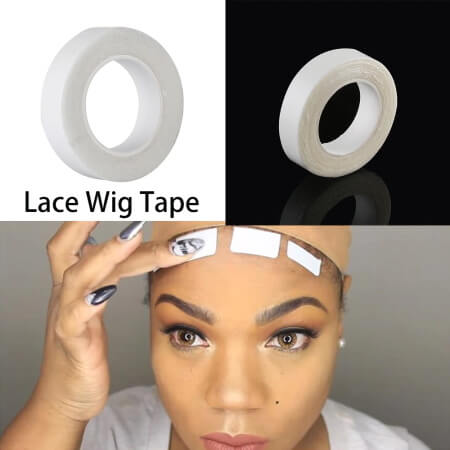
Wig tape is double-sided that is designed to help prevent a lace front wig from slipping during the day. And it is a great choice for those people without natural hair.
It’s a more scalp-friendly alternative to wig glue, particularly for those who have a sensitive scalp or are recovering from cancer treatment.
Not mention to a roll of tape will last you a long time! It’s definitely good value for money. If security for a long period is what you require, it’s most likely to be the best way to secure a wig for you.
How To Keep A Wig From Slipping With Wig Tape
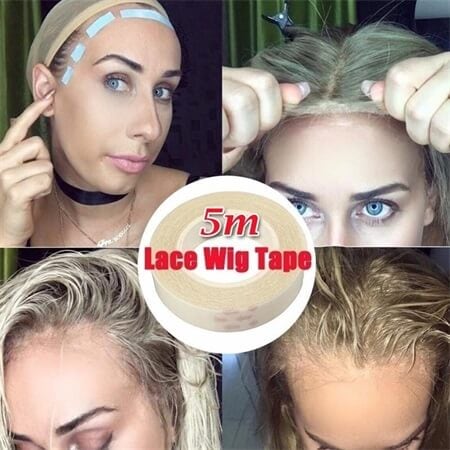
Step 1: Clean the area where you are going to place the tape to remove the excess oils and dirt, especially the skin near the hairline.
Step 2: Apply the tapes along your hairline carefully and make sure that tapes are relatively evenly distributed. Don’t apply the tapes to your natural hairline as it will rip out your hair when you remove the tapes.
Step 3: Before putting the wig on, remove the back of the tapes.
Step 4: Press the wig down along the tapes securely after you have placed the wig in the correct area.
To remove the wig tape effortlessly, simply soak a cotton pad into a wig-specific adhesive remover and rub over the sticky tape.
Con:
If you like to remove your wig every so often to cool your head, you may want to avoid wig tape as it's strong and designed to hold the wig on for a long time. Sometimes, it may occur the wig is firmly stuck in your head and can not be removed.
What are your favorite methods to keep the wig from slipping? Tell us your secret to keep the wig in place in the below comment.
